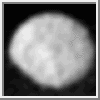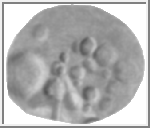Neptune's Moon Larissa (original) (raw)
Larissa
Neptune VII - 1989N2, 1981N1
Larissa [LA-ree-suh] is only about 48,800 kilometers (30,300 miles) from Neptune's clouds, and circles the planet in 13 hours, 18 minutes. Its diameter is about 190 kilometers (120 miles). It is irregularly shaped and shows no sign of any geological modification. Larissa circles the planet in the same direction as Neptune rotates, and remains close to Neptune's equatorial plane.
| Larissa Statistics | |
|---|---|
| Discovered by | Stephen Synnott |
| Date of discovery | 1989 |
| Mass (kg) | ? |
| Radius (km) | 104x89 |
| Radius (Earth = 1) | 1.6306e-02 |
| Mean density (gm/cm^3) | ? |
| Mean distance from Neptune (km) | 73,600 |
| Rotational period (days) | ? |
| Orbital period (days) | 0.554654 |
| Mean orbital velocity (km/sec) | 9.65 |
| Orbital eccentricity | 0.0014 |
| Orbital inclination (degrees) | 0.20 |
| Visual geometric albedo | 0.06 |
| Magnitude (Vo) | 22.0 |
 Larissa
Larissa
This image of Larissa was acquired by the Voyager 2 spacecraft on August 24, 1989. (Credit: Calvin J. Hamilton)
 Shaded Relief Map of Larissa
Shaded Relief Map of Larissa
This image is a shaded relief map of Larissa, a small inner satellite of Neptune. As with all maps, it is the cartographer's interpretation and not all features are necessarily certain given the limited data available. This interpretation stretches the data as far as is feasible. The leading side faces forwards in the orbit of Larissa. The trailing side faces backwards along the orbit. Longitude 0 is at the righthand end of the leading side, and faces Neptune. As with all conformal (true shape) projections, the scale in these maps varies, increasing from the centre to the outer edge.(Courtesy Phil Stooke)